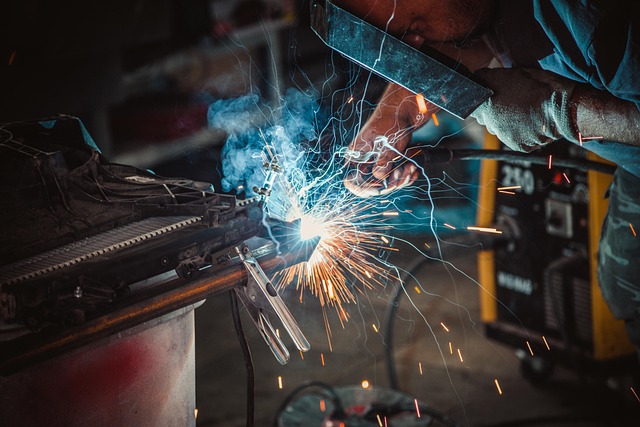EPA Compliant Body Shops: Leading the Charge for Corporate Social Responsibility
EPA compliant body shops prioritize environmental protection through adherence to EPA regulations, w…….
In an era where environmental consciousness is at an all-time high, the automotive industry is undergoing a quiet revolution. At the forefront of this change are EPA compliant body shops, facilities dedicated to repairing and restoring vehicles while adhering strictly to Environmental Protection Agency (EPA) standards. This article delves into the world of these eco-conscious workshops, exploring their definition, global impact, economic implications, technological innovations, regulatory landscape, challenges, case studies, and future potential. By the end, readers will gain a comprehensive understanding of why EPA compliance in body shops matters and how it is shaping the automotive sector’s sustainable future.
An EPA compliant body shop is an automotive repair facility that operates with a steadfast commitment to environmental stewardship. It goes beyond merely adhering to regulations by embracing best practices and technologies designed to minimize the ecological footprint of vehicle repairs. This includes proper disposal of hazardous materials, efficient use of resources, reduced emissions, and implementation of sustainable business models.
The concept emerged as a response to the growing awareness of environmental degradation caused by the automotive industry, particularly in relation to air pollution, waste generation, and resource depletion. Historically, body shops often contributed to these issues through improper disposal of toxic substances like lead-based paints, solvents, and asbestos. Today, EPA compliance is not just a legal requirement but a badge of honor among businesses prioritizing sustainability.
The influence of EPA compliant body shops extends far beyond U.S. borders, reflecting a global trend towards eco-friendly automotive practices. Several key trends are shaping this movement:
Regional Regulation Harmonization: Many countries have aligned their environmental standards with international frameworks, such as the European Union’s (EU) strict guidelines on waste management and emissions control. This makes it easier for body shops to maintain EPA compliance while operating internationally.
Increasing Public Awareness: Consumers worldwide are becoming more environmentally conscious, demanding sustainable options in all sectors, including automotive repairs. This shift in consumer behavior drives businesses towards eco-friendly practices.
Government Incentives and Subsidies: Several governments offer financial incentives for businesses adopting green technologies and practices. These rewards encourage body shops to invest in EPA compliance and sustainable operations.
Industry Collaboration: Global automotive manufacturers and repair chains are collaborating to share best practices, technologies, and standards, fostering a more unified approach to sustainability across regions.
The economic aspects of EPA compliant body shops are multifaceted, influencing both the repair industry and the broader economy. Here’s an analysis:
EPA compliant body shops contribute to economic systems by:
Technology plays a pivotal role in the evolution of EPA compliant body shops, enabling them to operate more efficiently and sustainably. Here are some significant advancements:
Digital Diagnostics: Advanced diagnostic tools allow for precise identification of vehicle issues, reducing the use of unnecessary parts and labor. This precision leads to more efficient repairs and less waste.
Automated Paint Systems: Robotic paint application systems offer enhanced accuracy and consistency, minimizing overspray and material waste. They also reduce energy consumption compared to traditional manual painting methods.
Waste Management Software: Specialized software optimizes waste segregation, recycling, and disposal processes, ensuring compliance with EPA regulations and maximizing resource recovery.
Renewable Energy Sources: Many body shops are adopting solar panels and wind turbines for electricity generation, reducing their carbon footprint and operational costs.
Water Recycling Systems: These systems treat and recycle water used in various processes, such as painting and cleaning, significantly reducing freshwater consumption.
The development of EPA compliant body shops is heavily influenced by policies, regulations, and legislative frameworks designed to protect the environment. Key players include:
EPA Regulations: The U.S. EPA sets standards for air and water emissions, hazardous waste management, and safe handling of toxic substances, providing a solid legal foundation for body shop compliance.
Local Ordinances: Cities and states often have additional regulations, such as strict waste disposal rules or specific emission standards, which body shops must adhere to alongside federal guidelines.
International Agreements: Global agreements like the Paris Climate Agreement influence national policies, pushing countries to adopt stricter environmental standards, including those for automotive sectors.
Industry Associations: Organizations like the National Automobile Body Repair and Refinishing Association (NABRRA) provide resources, training, and networking opportunities to help body shops navigate regulatory requirements.
Despite its numerous benefits, the path to EPA compliance is not without challenges. Common obstacles include:
Initial Cost Barrier: Implementing compliant practices can be expensive, especially for smaller body shops with limited resources. This often leads to concerns about affordability and profitability.
Training Needs: Staying current with technological advancements and regulatory changes requires continuous training, which can be a challenge for businesses already dealing with tight profit margins.
Lack of Standardization: Different regions have varying environmental standards, making it complex for body shops to operate across multiple jurisdictions while maintaining consistency in their practices.
Customer Awareness: Some customers may not fully grasp the importance of EPA compliance or be willing to pay a premium for eco-friendly services, posing challenges for body shops trying to promote their sustainable efforts.
Strategies to Overcome These Issues:
The following case studies illustrate successful EPA compliant body shop implementations, offering valuable insights into their strategies and outcomes:
Case Study 1: Green Auto Repair in Urban Center
Location: San Francisco, California, USA
Challenges: High cost of living, strict local regulations, and a competitive market.
Solution: “Eco-Repairs SF” adopted a multi-pronged approach, including investing in solar panels for energy, implementing a comprehensive recycling program, and offering online booking to reduce no-show rates. They also partnered with local car manufacturers to offer discounted services to their customers.
Outcome: Within two years, Eco-Repairs SF achieved a 30% increase in customer base, reduced operational costs by 25%, and received several industry awards for sustainability.
Case Study 2: Rural Body Shop’s Digital Transformation
Location: Farmville, Virginia, USA
Challenges: Limited access to advanced technologies, high reliance on manual processes, and a smaller customer base.
Solution: “Mountain View Auto Care” embraced digital diagnostics and automated paint systems, which improved efficiency and reduced waste. They also invested in online marketing to reach a wider audience.
Outcome: The shop saw a 40% increase in revenue within one year, largely attributed to their enhanced productivity and customer satisfaction ratings.
Case Study 3: International Network’s Standardized Approach
Location: Global (with significant operations in Europe)
Challenge: Operating across multiple countries with varying regulations while maintaining consistent sustainability practices.
Solution: “Global AutoCare” implemented a centralized sustainability program, including standardized training, waste management protocols, and reporting systems. They also leveraged technology for real-time data sharing and remote support.
Outcome: The network achieved 95% compliance across all locations, reduced overall environmental impact by 20%, and improved customer loyalty through its consistent eco-friendly image.
The future of EPA compliant body shops is promising, with several emerging trends shaping their trajectory:
Technology Integration: Artificial intelligence (AI) and the Internet of Things (IoT) will play increasingly significant roles in optimizing body shop operations, predictive maintenance, and energy management.
Circular Economy Focus: Body shops will continue to embrace circular economy principles, focusing on repairing, refurbishing, and recycling components to minimize resource depletion and waste generation.
Expansion into New Markets: As awareness grows, EPA compliance is likely to become a standard across all automotive services, creating opportunities for body shops to expand into new markets, including fleet management and electric vehicle (EV) repairs.
Regulatory Evolution: With increasing global cooperation on environmental issues, future regulations will probably be more harmonized and stringent, requiring body shops to remain agile and adaptable.
EPA compliant body shops represent a significant step towards a greener automotive industry. They not only contribute to environmental protection but also drive economic growth, foster innovation, and enhance customer awareness. As global trends continue to push for sustainability, these workshops will become increasingly integral to the automotive sector’s future. By embracing technology, collaboration, and best practices, body shops can ensure that their contributions to repairing and restoring vehicles leave a positive mark on both the industry and the planet.
Q: Are EPA compliant body shops more expensive than traditional repair facilities?
A: While initial costs for implementation might be higher, many body shops report improved profitability in the long term due to reduced operational expenses and better resource management. Additionally, government incentives and tax benefits can offset these initial investments.
Q: How do I know if a body shop is truly EPA compliant?
A: Look for certifications, awards, or membership in industry associations that verify their sustainability practices. Reputable shops should also be transparent about their processes and willing to discuss their environmental initiatives.
Q: Can EPA compliance help body shops attract more customers?
A: Absolutely! Increasingly, consumers are choosing businesses based on their environmental responsibilities. EPA compliance can enhance a body shop’s reputation, attracting eco-conscious customers and fostering brand loyalty.
Q: What role does technology play in EPA compliance?
A: Technology is crucial for enhancing efficiency, reducing waste, and ensuring compliance with regulations. From digital diagnostics to renewable energy sources, advanced technologies enable body shops to operate more sustainably while improving their bottom line.
Q: How can small body shops afford to become EPA compliant?
A: Small businesses can start by focusing on low-cost, high-impact changes, like proper waste segregation and recycling. They can also seek financial assistance from governments or industry organizations, collaborate with larger chains for knowledge sharing, and gradually implement more advanced solutions as their budget allows.

EPA compliant body shops prioritize environmental protection through adherence to EPA regulations, w…….

Running an EPA compliant body shop is vital for vehicle repair businesses, ensuring environmental pr…….

In EPA compliant body shops, high-efficiency particulate air (HEPA) filters are crucial for minimizi…….

The Environmental Protection Agency (EPA) compliance is paramount for vehicle body shops, as it sign…….

The Environmental Protection Agency (EPA) sets strict standards for auto repairs to protect both the…….

An EPA compliant body shop adheres to stringent environmental standards by implementing certified em…….

In the competitive auto repair industry, adhering to EPA compliance standards is vital for EPA compl…….